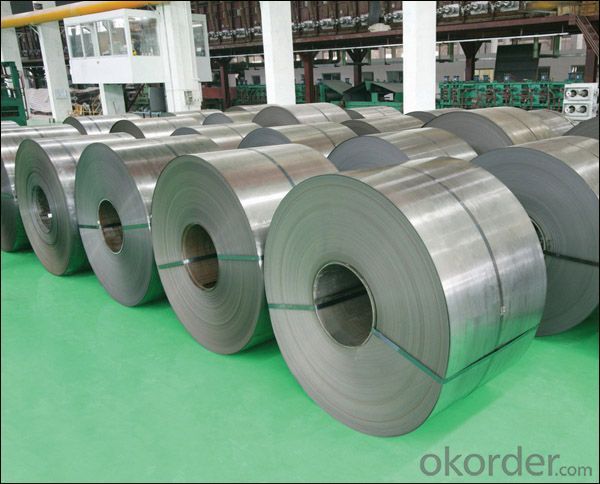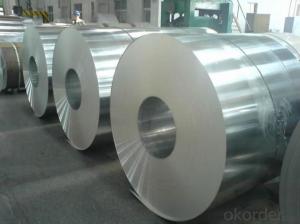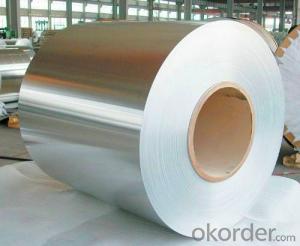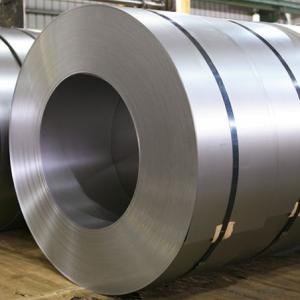Stainless Steel Coil Cold Rolled AISI 304 With Good Quality
- Loading Port:
- Shanghai
- Payment Terms:
- TT OR LC
- Min Order Qty:
- 100 m.t.
- Supply Capability:
- 5000 m.t./month
OKorder Service Pledge
OKorder Financial Service
You Might Also Like
Stainless Steel Coil Cold Rolled 304 With Good Quality
1.Structure of Stainless Steel Coil Cold Rolled 304 With Good Quality
Cold Rolled stainless steel Coil with good quality is one of the raw material of the cold rolled stainless steel Coil, which can be used directly in many places. Stainless Steel (Stainless Steel) is short for acid-proof Stainless Steel, resistant to weak corrosive medium such as air, steam, water, or with a Stainless Steel grade.
2.Main Features of Prefabricated Steel Structure High Building Project
1) Weldability: The purpose of the different requirement for welding performance are different.1 Kind of tableware generally do not require the performance of welding, even including some pot class enterprise. But the vast majority of products all need raw materials welding performance is good, like the 2 kinds of tableware, thermos flask, steel pipes, water heaters, water dispensers, etc.
2) Corrosion resistance The vast majority of stainless steel products for corrosion resistant performance is good, like a, 2 kinds of tableware, kitchen utensils and appliances, water heaters, water dispensers, etc., some foreign businessmen on corrosion resistance of products also do experiment: in NACL aqueous solution heated to boiling, after a period of time the best solution, wash and drying, weight loss, to determine the degree of corrosion (note: the product polishing, because of the sand cloth or sandpaper containing Fe, will cause the test surface rust spots)
3. Stainless Steel Coil Cold Rolled 304 With Good Quality Images


4. Stainless Steel Coil Cold Rolled 304 With Good Quality Specification
The word "stainless steel" is not merely refers to a pure stainless steel, but said more than one hundred kinds of stainless steel industry, the development of each stainless steel has good performance in their specific applications. The key to the success of the first is to make clear purpose, and then determine the correct material. Related to architectural construction applications usually only six types of steel. They contain 17 ~ 22% chromium, good steel contains nickel. Add molybdenum can further improve the atmospheric corrosion resistance, especially containing chloride atmospheric corrosion resistance. Stainless steel often according to the state of organization can be divided into: martensite steel, ferritic steel, austenitic steel, austenitic (two-phase) - ferrite stainless steel and precipitation hardening stainless steel, etc. In addition, according to ingredients can be divided into: chromium stainless steel, chromium nickel stainless steel and chromium manganese nitrogen stainless steel, etc.
5. Applications of Stainless Steel Coil 304 With Good Quality
1. Kitchenware: tableware, cookware, Stoves…
2. Food packing: storage cans, food containers…
3. Construction: bridge, roofing, wall, decoration, bathroom accessories…
4. Precision instruments: electrical products, aerospace…
5. Others: automotive parts, machine building, chemical processing, farming…
6.FAQ of Stainless Steel Coil 304 With Good Quality
We have organized several common questions for our clients,may help you sincerely:
①How about your company?
A world class manufacturer & supplier of castings forging in carbon steel and alloy steel,is one of the large-scale professional investment casting production bases in China,consisting of both casting foundry forging and machining factory. Annually more than 8000 tons Precision casting and forging parts are exported to markets in Europe,America and Japan. OEM casting and forging service available according to customer’s requirements.
②How to guarantee the quality of the products?
We have established the international advanced quality management system,every link from raw material to final product we have strict quality test;We resolutely put an end to unqualified products flowing into the market. At the same time, we will provide necessary follow-up service assurance.
③How is the packaging and delivery?
Standard export packing (Coil: waterproof paper + protective steel ring; Circle: wooden box), or as your requirement and the delivery term is based on the project.
④How long can we receive the product after purchase?
In the purchase of product within 20 working days, We will arrange the factory delivery as soon as possible. The specific time of receiving is related to the state and position of customers. Commonly 20 to 40 working days can be served.
- Q: Can stainless steel strips be cut to custom sizes?
- Indeed, custom sizes can be achieved by cutting stainless steel strips. These strips offer great flexibility and can be effortlessly tailored to desired lengths or widths in order to cater to individual needs. The task can be accomplished through a range of cutting techniques including shearing, laser cutting, or sawing. By customizing the cutting process of stainless steel strips, one can attain precise dimensions, guaranteeing an impeccable match for particular applications or projects.
- Q: Can stainless steel strips be used for architectural canopies?
- Yes, stainless steel strips can be used for architectural canopies. Stainless steel is a highly durable and corrosion-resistant material, making it suitable for outdoor applications such as canopies. It provides a sleek and modern aesthetic, adding an elegant touch to architectural designs. Stainless steel strips can be easily formed and fabricated into various shapes and sizes, allowing for customized canopy designs. Additionally, stainless steel's strength and resistance to harsh weather conditions make it a reliable choice for long-lasting canopies.
- Q: How do stainless steel strips perform in high-humidity environments?
- Stainless steel strips are highly resistant to corrosion and are therefore suitable for use in high-humidity environments. The chromium content in stainless steel forms a protective layer on the surface, preventing the metal from interacting with moisture and humidity. This protective layer, known as the passive film, remains intact even in high-humidity conditions, ensuring that the stainless steel strip maintains its structural integrity. Additionally, stainless steel has a low thermal conductivity, which means it does not easily absorb or retain moisture from the surrounding environment. This property further enhances its performance in high-humidity environments by reducing the risk of moisture buildup and subsequent corrosion. In summary, stainless steel strips are an excellent choice for applications in high-humidity environments due to their corrosion-resistant properties and ability to withstand moisture without compromising their performance or structural integrity.
- Q: Can stainless steel strips be used in nuclear power applications?
- Certainly, stainless steel strips are applicable in nuclear power uses. Due to its exceptional resistance to corrosion, high-temperature strength, and low magnetic permeability, stainless steel is highly favored in the nuclear industry. It finds widespread use in reactor components, fuel storage containers, heat exchangers, and piping systems. The versatility of stainless steel strips lies in their ease of being molded into different shapes and sizes, making them ideal for various nuclear power applications. Moreover, stainless steel's capability to endure radiation damage and its limited interaction with nuclear fuel further enhance its suitability for nuclear power uses.
- Q: Can stainless steel strips be used in watchmaking?
- Yes, stainless steel strips can be used in watchmaking. Stainless steel is a popular material choice in watchmaking due to its durability, resistance to corrosion, and aesthetic appeal. Stainless steel strips are commonly used to create watch cases, bracelets, and other components. The material is known for its strength, making it suitable for protecting the delicate inner workings of a watch. Additionally, stainless steel is often used in both luxury and affordable watches, making it a versatile option for watchmakers.
- Q: Stainless steel narrow band, what are the spare rolls and side bands?
- Volume: due to the use of the problem, customers may come to buy materials, do not buy the entire volume of material, but cut the plate for sale, the remaining less than a roll of materialMaterials, called rolls, are lower in price than normal materials.
- Q: Can stainless steel strips be used for solar water heaters?
- Yes, stainless steel strips can be used for solar water heaters. Stainless steel is a durable and corrosion-resistant material that can withstand the harsh conditions of solar water heating systems. It is commonly used for the construction of the collector panels, heat exchangers, and pipes in solar water heaters.
- Q: Can stainless steel strips be used in architectural applications?
- Yes, stainless steel strips can be used in architectural applications. Stainless steel is highly durable, corrosion-resistant, and can be easily formed into various shapes and sizes. It is commonly used in architectural designs for cladding, roofing, handrails, and decorative elements due to its aesthetic appeal and long-lasting performance.
- Q: Can stainless steel strips be used in petrochemical applications?
- Yes, stainless steel strips can be used in petrochemical applications. Stainless steel is highly resistant to corrosion, heat, and chemicals, making it suitable for various harsh environments, including petrochemical plants. Stainless steel strips offer durability, strength, and excellent performance in handling and transporting petrochemicals, making them a reliable choice for such applications.
- Q: The difference between stainless steel and cold rolled steel strip
- It: cold rolled steel strength is very high, but the toughness and weldability is poor, hard, crisp, bright surface
Send your message to us
Stainless Steel Coil Cold Rolled AISI 304 With Good Quality
- Loading Port:
- Shanghai
- Payment Terms:
- TT OR LC
- Min Order Qty:
- 100 m.t.
- Supply Capability:
- 5000 m.t./month
OKorder Service Pledge
OKorder Financial Service
Similar products
Hot products
Hot Searches
Related keywords



























